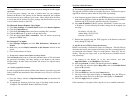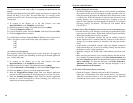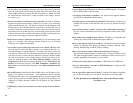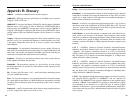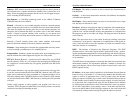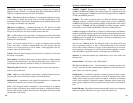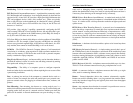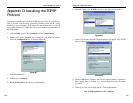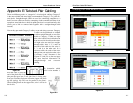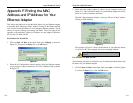
EtherFast
®
Cable/DSL Routers
nostic tool or debugging feature, especially when fending off an attack. It
enables the administrator to keep close track of switch performance and alter it
if necessary. Port mirroring can be managed locally or remotely.
PPPoE (Point to Point Protocol over Ethernet) - A method used mostly by DSL
providers for connecting personal computers to a broadband modem for Internet
access. It is similar to how a dial-up connection works but at higher speeds and
quicker access.
PPTP (Point-to-Point Tunneling Protocol) - A protocol (set of communication
rules) that allows corporations to extend their own corporate network through
private “tunnels” over the public Internet. Effectively, a corporation uses a wide-
area network as a single large local area network. A company no longer needs
to lease its own lines for wide-area communication but can securely use the pub-
lic networks. This kind of interconnection is known as a virtual private network
(VPN).
PrintServer - A hardware device that enables a printer to be located anywhere
in the network.
RIP (Routing Information Protocol) - A simple routing protocol that is part of
the TCP/IP protocol suite. It determines a route based on the smallest hop count
between source and destination. RIP is a distance vector protocol that routinely
broadcasts routing information to its neighboring routers and is known to waste
bandwidth. AppleTalk, DECnet, TCP/IP, NetWare, and VINES all use incom-
patible versions of RIP.
RJ-11 (Registered Jack-11) - A telephone connector that holds up to six wires.
The RJ-11 is the common connector used to plug a telephone into a wall.
RJ-45 - A connector similar to a telephone connector that holds up to eight
wires, used for connecting Ethernet devices.
Router - Protocol-dependent device that connects subnetworks together.
Routers are useful in breaking down a very large network into smaller subnet-
works; they introduce longer delays and typically have much lower throughput
rates than bridges.
Server - Any computer whose function in a network is to provide user access to
files, printing, communications, and other services.
101
Instant Broadband
™
Series
Partitioning - To divide a resource or application into smaller pieces.
PCI (Peripheral Component Interconnect) - A peripheral bus commonly used in
PCs, Macintoshes and workstations. It was designed primarily by Intel and first
appeared on PCs in late 1993. PCI provides a high-speed data path between the
CPU and peripheral devices (video, disk, network, etc.). There are typically
three or four PCI slots on the motherboard. In a Pentium PC, there is generally
a mix of PCI and ISA slots or PCI and EISA slots. Early on, the PCI bus was
known as a “local bus.”
PCI provides “plug and play” capability, automatically configuring the PCI
cards at startup. When PCI is used with the ISA bus, the only thing that is gen-
erally required is to indicate in the CMOS memory which IRQs are already in
use by ISA cards. PCI takes care of the rest.
PCI allows IRQs to be shared, which helps to solve the problem of limited IRQs
available on a PC. For example, if there were only one IRQ left over after ISA
devices were given their required IRQs, all PCI devices could share it. In a PCI-
only machine, there cannot be insufficient IRQs, as all can be shared.
PCMCIA - The PCMCIA (Personal Computer Memory Card International
Association) is an industry group organized in 1989 to promote standards for a
credit card-size memory or I/O device that would fit into a personal computer,
usually a notebook or laptop computer.
Ping (Packet INternet Groper) - An Internet utility used to determine whether a
particular IP address is online. It is used to test and debug a network by sending
out a packet and waiting for a response.
Plug-and-Play - The ability of a computer system to configure expansion
boards and other devices automatically without requiring the user to turn off the
system during installation.
Port - A pathway into and out of the computer or a network device such as a
switch or router. For example, the serial and parallel ports on a personal com-
puter are external sockets for plugging in communications lines, modems, and
printers.
Port Mirroring - Port mirroring, also known as a roving analysis port, is a
method of monitoring network traffic that forwards a copy of each incoming and
outgoing packet from one port of a network switch to another port where the
packet can be studied. A network administrator uses port mirroring as a diag-
100



